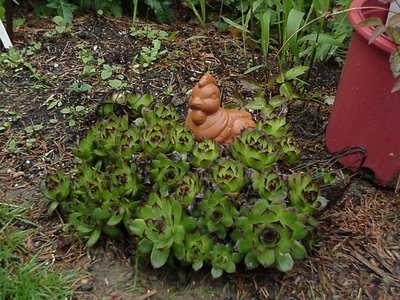
Grown on rooftops in Germanic and Scandinavian countries to avert lightning, ostensibly because it was sacred to the god Thor, Sempervivums are now being used as "green roof" plants.
Mine are planted in corners and niches where I want a little lagniappe of interest. This photo shows them in a chicken shaped wire egg basket with a broken crockery chicken stuck in the top where the mother plant died last year after blooming and sending out her chicks.
This link is to is another website concerning these easy favorites and other succulents. Here is a "copy and paste" snippet:
CRASSULACEAE IN ANCIENT ROME:
Crassulaceae were indeed cultivated in antiquity, but only a few. This family usually grows in regions with consistent higher temperatures and no frost in winter. Nevertheless there are some genera which are native in the area of ancient rome and greece.
THE reference for plants in ancient rome is 'Naturalis Historiae' by Pliny the Elder (C. Plinii Secundi).
In his books he describes hundreds of plants in use during his time, mostly medicinal and agricultural plants. The crassulaceae described by Pliny had mostly medicinal uses, but also mythological.
The Sempervivum was planted on roofs of houses to protect the house against lightning. The plants of this genus were considered sacred to Jupiter in Roman and to Thor in Teutonic mythology.
Jupiter and Thor were associated with thunderbolts - it is said their beard can be seen in the flowers, hence the Romans also called it 'Jupiter's Beard' (Jovis Barbam). It was also cultivated in pots and beds in roman gardens.
This habit is not as far fetched as one might think - todays science has an explanation:
Due the acute (pointed) leaves, the equalisation of the electrical charge between the house and the air is eased, therefore the chance of a spark discharge is lowered. Sure this effect might be tiny, but in case of a lightning bolt it can be essential if it discharges or not.
Sempervivums are known as rosette-leaf succulents. It's latin name splits up into Semper - always and vivum - living. We commonly know the Sempervivum as houseleek, 'Hen and Chicks' or Jupiter's Beard.
All plants of this genus are more or less cold-hardy. They are native to central and southern Europe, the islands of the Mediterranean and northern Africa. Furthermore they grow in regions at sea-level, but also in alpine regions.
The myth of the protective feature for house was adopted in medieval times and was documented in Charlemagne's (Karl der Große) "capitulare de villis":
§70: [...] Et ille hortulanus habeat super domum suam Iovis barbam. [...]
"And there the gardener ought to have the 'Iovis barbam' over his own house."
Sempervivum as medicine:
The roman-greek scholar Dioscorides (Dioskurides) (~40-~90AD) mentioned the sempervivum in his work 'De materia medica' and recommended crushed leaves with wine to get rid of intestinal parasites. Mashed leaved were also used to treat burns and scalds. Cut leaves were used against warts, calluses, corns and insect stings - the juice was used to treat shingles and earache.
'Naturalis Historiae' by Pliny the Elder is by far the best reference for uses of the Sempervivum. In countless passages he mentions the Sempervivum against articular gout, diarrhea, worms, stomach pain and more. The usage was either internal (juice), rubbing on the area of pain or simply applying parts of the plant on the body.
Pliny uses several names for one species, but comparisons with other ancient authors lead to a certainty for attributing to modern species names.
Sempervivum
Pliny sci-name common name
aeizoon Sempervivum aizoon (Bolle) Christ. Hauswurz; houseleek
aizoum Sempervivum tectorum L.
sedum Sempervivum L. Eigentliche Hauswurz; houseleek
Other common names: Houseleek, Jupiter's Eye, Jupiter's Beard, Thor's Beard, Bullock's Eye, Sengreen, Ayron, Ayegreen, Donnersbart
[preliminary version]
© 2003 Captain
last modified: 11-JUN-2003